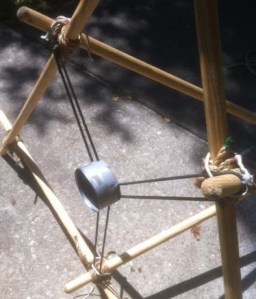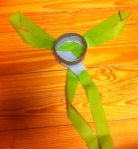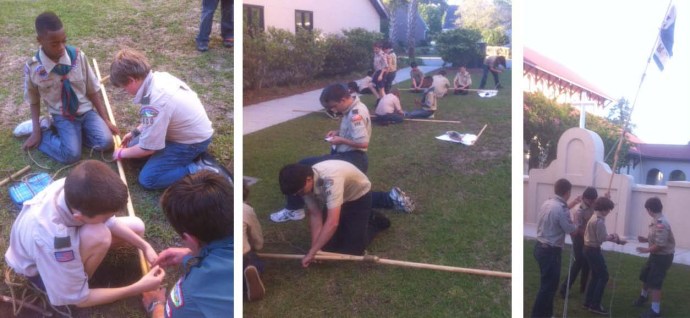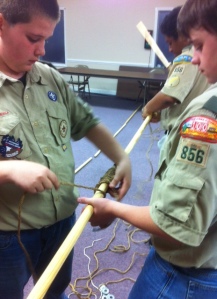First of all, let’s acknowledge what appears to be the source for this easy-to-execute design, the website for: Scouts South Africa where you can download a pdf of the design and directions. The activity surrounding the construction of this launcher incorporates sound square lashing technique, teamwork (of course), a geometric study of angles and trajectory, some concentration, and lots of laughter. The ensuing fun can be a real blast, indoors or outdoors*.
Here’s what each patrol will need:
- six Scout Staves
- seven 6-foot x 1/4-inch lashing ropes
- three short lengths of cord (to secure the shot holder to the structure if your using surgical tubing)
- one pre-made “shot-holder”
- large supply of newspaper and masking or scotch tape
- large enough room to spread out
In a nut shell, here’s what happens:
An indoor or outdoor area is set up so there’s plenty of room to launch the “shots.” Each patrol is provided the necessary materials along with the design drawing. They are each assigned their own designated area (about 10′ x 10′) in which they must stay. On signal, they race to build their Scout Stave Launcher. Using the newspaper and tape, they will also have to set to work and make a supply of “shots.” As soon as they are ready, they can proceed to launch tightly, taped-together newspaper “shots” at designated targets in the shooting area. They can also launch the “shots” for distance.
It should be noted, the “locking bar” (refer to the drawing) is only lashed to the bottom crossbar of the A-frame. The angle of fire is adjusted by moving the “locking bar” up and back. Printable Diagram
Each launching can serve as a point of reference to adjust the “locking bar” and, if necessary, the position of the elastic bands. Remember, the patrol must stay within their duly designated area. Used “shots” can be retrieved at defined intervals, during which no further launching can take place until an “all clear” is sounded.
Making a Shot Holder—the most simple approach:
- Cut out an equilateral triangle with 12-inch sides from a piece of canvas. 10-oz canvas will work if you double one triangle on top of another.
- Place a grommet on each corner of the triangle(s).
- Reeve a 24-inch length of surgical tubing through each grommet and make a loop by joining the ends of each with a tight knot.
- If you choose, you can add another grommet to the middle and use it to fashion a pull line.
Tin can shot holder—another approach that works well is as follows:
For each shot holder, you’ll need a can and a length of surgical tube, inner tube, or some kind of stretch band. Six feet works well with Scout staves.
Prepare the cans. Using 12.5 oz. cans (commonly filled with canned chicken or beef) cut three slits in the bottom the same width as the rubber strips or more narrow if you’re using surgical tubing. Flatten the sharp edges as much as possible against the inside of the can and then apply tape to serve as a cushion between the slits and the stretch material.
The stretch material. One bicycle inner tube can be cut into three to four 6′ strips each of which are just the right size for one shot holder. If you can’t easily obtain inner tube, heavy duty exercise stretch bands work okay, but are less durable. What works best by far are six foot lengths of 1/4″ surgical tubing! They’re the most stretchy and can withstand a lot of strain. Surgical tubing can be purchased through scuba supply companies.
Attach the rubber. Tie together the ends of the rubber strip or surgical tube making one loop with a circumference of approximately six feet. Feed the loop through one slit in the can. The objective here is to extend an even-sized loop through each slit, by forming bights in the loop and threading them through the other two slits.
*Outdoor action can give rise to a host of variations. “Shots” can consist of tennis balls, and targets can be set up at varying distances. Depending on the elastic bands used to make the shot holder, this simple design can easily launch well over a hundred feet.
NOTE: Eye protection and supervision by an NCS trained shooting sports director is required for this activity.














